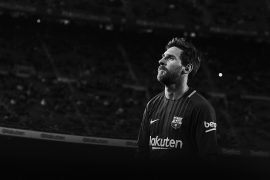[dropcap letter=”I”]
f we look at football philosophically, it seems appropriate to focus on the phenomenon that comes to mind when we participate in a football experience. This method, phenomenology, is explicitly used by Simon Critchley in his excellent essay What We Think About When We Think About Football (Profile Books), which we will discuss on other occasions. From the multiplicity of nuances that characterize the phenomena of sports competition, I propose to focus on those that belong to the field of aesthetics.
 Football then appears as an activity to which we can attribute properties traditionally associated with art, such as beauty, the sublime or ugliness. We contemplate a game in a meditative way, in the hope that “moment of moments occurs”, says Critchley, in which a collective shudder happens, affirming an identity of its own. This collective expression is usually associated to scoring a goal, as if the primary purpose of the teams were to beat each other at any price. On the contrary, it seems necessary to cultivate an aesthetic that avoids this goal-centrism, transcending the matter of mere results. It is a tantric football experience, so to speak, that does not pursue orgasm desperately. The meditative concentration of the spectator is not directed to the satisfaction of a desire for victory, but rather to the hope of participating in an extraordinary event.
Football then appears as an activity to which we can attribute properties traditionally associated with art, such as beauty, the sublime or ugliness. We contemplate a game in a meditative way, in the hope that “moment of moments occurs”, says Critchley, in which a collective shudder happens, affirming an identity of its own. This collective expression is usually associated to scoring a goal, as if the primary purpose of the teams were to beat each other at any price. On the contrary, it seems necessary to cultivate an aesthetic that avoids this goal-centrism, transcending the matter of mere results. It is a tantric football experience, so to speak, that does not pursue orgasm desperately. The meditative concentration of the spectator is not directed to the satisfaction of a desire for victory, but rather to the hope of participating in an extraordinary event.
In the 21st century, the achievements have modified the mind of the culers (Barça supporters), that no longer need to be hopeful, but rather go to the stadium to attend the regular repetition of miracles.
For example, in the 80s and 90s, the expectation of Barcelona fans was to see epic (Tenerife), major recoveries (Gothenburg), saving goals (Kaiserslautern). A hope that is consumed in an instant and savoured the rest of the life. In the 21st century, the achievements have modified the mind of the culers (Barça supporters), that no longer need to be hopeful, but rather go to the stadium to attend the regular repetition miracles. Needless to say, that will also reach an end, and then hope will be necessary again, in this case the return of the messiah.
The moment of moments that the viewer expects to live is eminently aesthetic. It is about attending the completion of a successful athletic performance. What do we celebrate in those specific moments? German philosopher Martin Seel maintains in a 1993 an article that an incapacity is celebrated in the momentous moments of the sports competition, in particular, the inability to do what it is tried to do, and that only few times is actually done. Seel writes that to be successful in the competition, that is, to participate successfully in a top-level sporting event, at the decisive moment athletes should transcend what they can do, surrendering to the movement of their body. It is therefore a capacity that is not controlled but depends on a involuntary body response.
It can also be defined as a form of intelligence, as Daniel Dennett commented on his recent visit to Barcelona, quoting Piaget and Claxton, which is to know what to do when one does not know what to do.
The danger and, therefore, the trigger of the moment of moments, lies in the limit. Breaking an offside, pressing the bottom line, dribbling just before the tackle, stroking the stalker. The one who lives closer to the limit in the best manner, and knows how to overcome it in his favour, will be the winner.
Talking about football from Barcelona today is talking about Lionel Messi. Its grandeur lies precisely in the regular manifestation of a successful challenge to what seems impossible. What is celebrated as such is a form of intelligence that is not only an athletic benefit but also an adaptation to the earthly conditions and to the laws that govern the interaction between the elements. His constant challenge to human physics is possible thanks to the perfect adequation to the circumstances and the unexpected of the sporting event. The green rectangle is the optimal biotope for his deployment in the game. As soon as Messi enters the pitch, a symbiosis is manifested with the sport. A symbiosis that is not only caused by tenacity and talent, but rather requires an immutable faith according to which, once he decides to go for it, he knows destiny will favour him.
The danger and, therefore, the trigger of the moment of moments, lies in the limit. Breaking an offside, pressing the bottom line, dribbling just before the tackle, stroking the stalker. The one who lives closer to the limit in the best manner, and knows how to overcome it in his favour, will be the winner; not because he always wins (this is impossible and undesirable), but because he will have created the conditions so that fans can participate in something bigger than the game, an experience of collective aesthetic happiness, ephemeral and persistent at the same time.
Athletes who know how to provoke repeatedly situations in which they end up doing things that they do not fully control are not artists. They are rather the work of art itself. Jaime Gil de Biedma said that he had spent his life trying to be a poet, until he realized that what he really wanted was to be a poem. The athlete, who enables in the fans the repeated celebration of the involuntary overcoming of his/her incapacities, turns him/herself into a work of global art, deriving from a kind of athletic beauty that is massively merchandized.


















